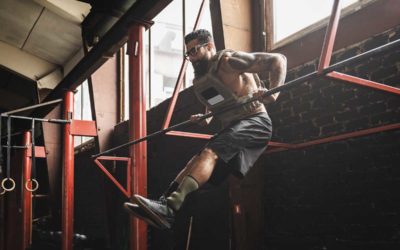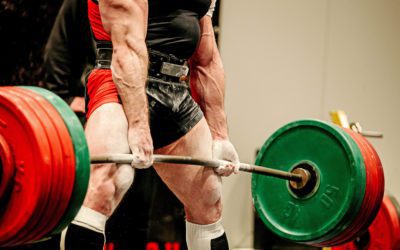The Best Exercises for Developing Speed
TOPIC: Speed & Agility | Sports Performance
Want to run faster? It’s not just about sprinting more. The real secret lies in the weight room. Strength training builds the raw power, stability, and mechanics that turn into explosive speed on the field or track. Here’s how to train smarter and unlock your fastest sprint yet.

Written By
travis hansen
Travis is a Certified Personal Trainer and celebrated author with over 15 years of experience training thousands of members toward their fitness goals.
Insta
Website
How to Build Explosive Speed Through Weight Training
Across the industry, you’ll often hear coaches and athletes praise the benefits of strength training for speed—and for good reason. For decades, strength training has been a reliable foundation for helping athletes run faster.
Like most fitness topics, you can make it as simple or as complex as you want. At its simplest, strength training teaches an athlete to drive more force into the ground to move the body forward. But when you dig deeper, the nuances of the science begin to emerge, showing why strength training for speed has continued to evolve.
To make this easier to digest, let’s look at a basic spectrum that runs from general to specific. On one end, we have broad methods like maximum strength and accessory strength. On the other, we have more targeted methods like special strength and strength-speed drills. By the end, you’ll have a complete picture of how strength training supports speed development.
Category #1: Maximum Strength
Maximum strength is the amount of voluntary force you can produce in a single effort. Even though force output during sprinting has natural limitations, the goal remains the same: put as much force into the ground as possible. Classic lifts like back squats, box squats, and deadlifts are staples here, building the raw leg and core power athletes need to run faster.
Category #2: Accessory Strength
Accessory, or “supplemental,” strength targets specific muscle groups and movement patterns. Think lunge variations, step-ups, RDLs, or SLDLs. These movements have been shown repeatedly in research to improve sprinting speed.
Not only do they strengthen the key muscles that drive sprint performance, but many are single-leg in nature. And what is sprinting if not a transfer of momentum from one leg to the other? This makes accessory movements a natural fit for developing speed.

Category #3: Special Strength
So far, we’ve covered the general and semi-specific techniques. Now let’s move into the most specific methods: drills that directly target the exact muscles, patterns, and ranges of motion used in sprinting.
Deep Hip Flexors
Research has shown that elite sprinters often have larger, stronger hip flexors than their slower counterparts. Training the psoas not only improves hip drive, but also boosts glute activation through the crossed extensor reflex. Heavy isometric deep squats, high box step-ups, and resisted mountain climbers are excellent options here.
Hamstrings and Glutes
Glutes get plenty of attention when it comes to speed, but hamstrings deserve equal focus. Exercises like reverse hypers (standard and modified) specifically overload the hamstrings and glutes in sprint-like positions. Reverse hypers also strengthen hip hyperextension, a critical role of the hamstrings in sprinting. Could their absence in many modern programs be a factor in hamstring injuries? Very likely.
Another valuable option is the snatch grip hip drive, introduced by Chris Korfist and further developed by Coach Brann Swinnen, which directly trains the posterior chain in sprint-specific mechanics.
Category #4: Strength-Speed Drills
Strength-speed drills are some of the oldest tools in speed training. While many of them are outdated or overhyped, a few still carry real value. A good example is the quarter speed squat.
This category is essentially modern-day velocity-based training (VBT), emphasizing central nervous system adaptations rather than muscle-specific development. When applied correctly, these drills help athletes bridge the gap between strength and speed.
Final Thoughts
Strength training for speed is more than just lifting heavy weights. It’s about building a spectrum of qualities that transfer directly to sprinting. Maximum strength lays the foundation, accessory strength refines it, special strength connects it directly to sprint mechanics, and strength-speed drills fine-tune nervous system efficiency.
By blending these categories, athletes and coaches can create programs that don’t just build strength, but turn that strength into speed where it matters most: on the field, the track, or the court.
Find Your Perfect Training Plan
Sometimes all you need to reach your destination on your fitness journey is an expert guide. Look no further, we've got you covered. Browse from thousands of programs for any goal and every type of athlete.
Try any programming subscription FREE for 7 days!
Related Articles
You May Also Like...
Why Plyometrics Are Essential As You Age
As we age, our bodies slow and our power output trends downward. This affects a ton of fitness factors like your speed, balance, agility and the “pep in your step” later in life. Adding some simple plyos to your current training routine will give you an edge on your...
Nervous System Training 101: The Creation of Superhuman Strength and Athleticism
Most athletes train their muscles. The smart ones train their nervous system. If you want to move faster, lift heavier, and feel more explosive than ever, it’s time to go beyond brute strength. Nervous system training targets the real source of athletic power—your...
32 & Lifting: Reflections on My First Powerlifting Competition
Stepping onto the powerlifting platform at 32, just 13 months post-ACL surgery, Fred Ormerod chronicles his return to competitive sports after a 14-year hiatus. From shedding over 15kg to meet weight class requirements to confronting self-doubt and embracing the...
Why Plyometrics Are Essential As You Age
As we age, our bodies slow and our power output trends downward. This affects a ton of fitness factors like your speed, balance, agility and the “pep in your step” later in life. Adding some simple plyos to your current training routine will give you an edge on your...
Nervous System Training 101: The Creation of Superhuman Strength and Athleticism
A whole book (or several) could be written about the idea of overloading the specific movements you are trying to improve in, but here is the key idea: The brain will generally wire movements towards efficiency rather than proficiency if allowed to do so.

Want more training content?
Subscribe
For Coaches
For Athletes
About
Support
Training Lab
Access the latest articles, reviews, and case studies from the top strength and conditioning minds in the TH Training Lab!
Made with love, sweat, protein isolate and hard work in Denver, CO
© 2024 TrainHeroic, Inc. All rights reserved.





